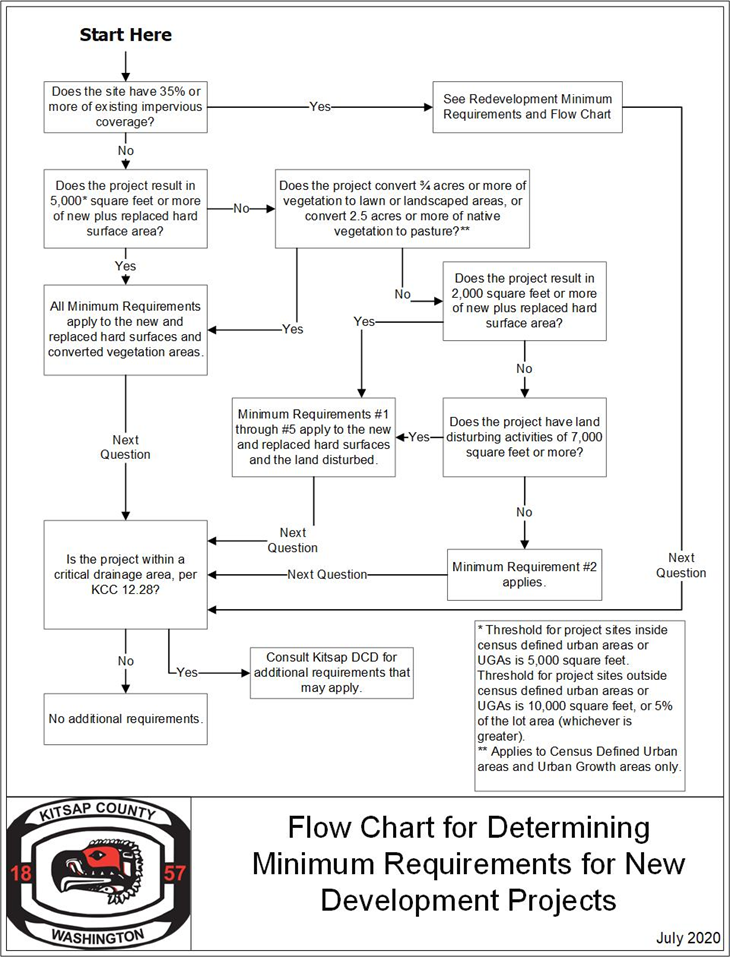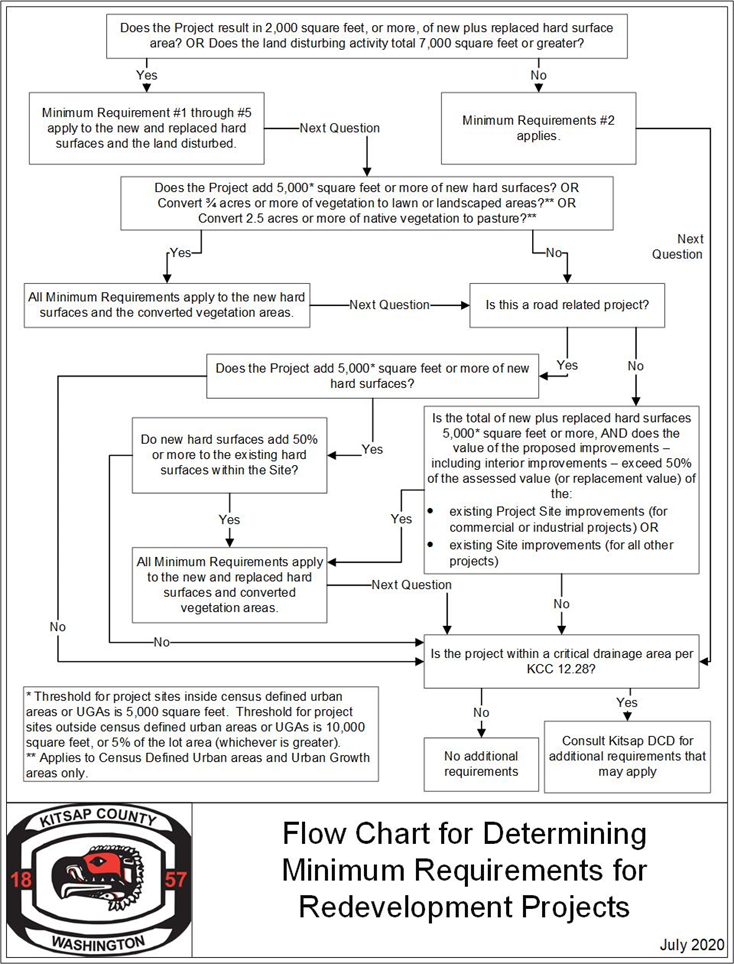Chapter 12.20
STORMWATER MANAGEMENT
Sections:
12.20.010 Minimum requirements for new and redevelopment projects.
12.20.020 Approved hydrological methods for design.
12.20.030 Source control of existing development.
12.20.040 Stormwater management facility and best management practices (BMPs) design requirements.
12.20.060 Manufactured treatment devices.
12.20.090 Stormwater conveyance facilities.
12.20.100 Easements, tracts and covenants.
12.20.120 Regional facilities.
12.20.010 Minimum requirements for new and redevelopment projects.
Not all minimum requirements apply to every development or redevelopment project. The applicability varies depending on the project type and size. This section identifies thresholds that determine the applicability of the minimum requirements for new and redevelopment projects and is consistent with the Ecology Manual. Use the flow charts in Figures I-4.1 and I-4.2 to determine which of the minimum requirements apply. The minimum requirements are presented in Section 4.2, Volume I of the Kitsap manual.
(1) New Development. All new development shall be required to comply with minimum requirement No. 2.
(A) The following new development shall comply with minimum requirements Nos. 1 through 5 for the new and replaced hard surfaces and for the land disturbed when the development:
1. Results in two thousand square feet, or greater, of new plus replaced hard surface area; or
2. Has land disturbing activity of seven thousand square feet or greater.
(B) The following new development shall comply with minimum requirements Nos. 1 through 9 for the new and replaced hard surfaces and the converted vegetation areas when the development:
1. Includes grading involving the movement of five thousand cubic yards or more of material; or
2. For sites located inside census-defined urban areas:
a. Results in five thousand square feet, or greater, of new plus replaced hard surface area, or
b. Converts three-quarters acre, or more, of vegetation to lawn or landscaped areas, or
c. Converts two and one-half acres, or more, of native vegetation to pasture;
3. For sites located outside census-defined urban areas or UGAs, results in ten thousand square feet or more of new plus replaced hard surface area, or results in five percent or more of hard surface area covering the lot area (whichever is greater).
(2) Redevelopment. All redevelopment shall be required to comply with minimum requirement No. 2.
(A) The following redevelopment shall comply with minimum requirements Nos. 1 through 5 for the new and replaced hard surfaces and the land disturbed when the development:
1. Results in two thousand square feet, or more, of new plus replaced hard surface area, or
2. Has land disturbing activity of seven thousand square feet or greater.
(B) The following redevelopment shall comply with minimum requirements Nos. 1 through 9 for the new and replaced hard surfaces and converted vegetation areas when the development:
1. Includes grading involving the movement of five thousand cubic yards or more of material; or
2. For sites located inside census-defined urban areas:
a. Adds five thousand square feet or more of new hard surfaces, or
b. Converts three-quarters acre, or more, of vegetation to lawn or landscaped areas, or
c. Converts two and one-half acres, or more, of native vegetation to pasture, or
d. Is a road-related project that adds five thousand square feet or more of new plus replaced hard surfaces, and:
i. For commercial or industrial projects: the valuation of proposed improvements, including interior improvements, exceeds fifty percent of the assessed value of the existing project site improvements;
ii. For all other projects: the valuation of the proposed improvements, including interior improvements, exceeds fifty percent of the assessed value of the existing site improvements;
3. For sites located outside census-defined urban areas or UGAs, adds ten thousand square feet or more of new hard surface area, or results in five percent or more of hard surface area covering the lot area (whichever is greater).

Figure I-4.1 – Flow Chart for Determining Requirements for New Development

Figure I-4.2 – Flow Chart for Determining Requirements for Redevelopment
(Ord. 599 (2021) § 36, 2021; Ord. 540 (2016) § 4 (Att. 1) (part), 2016)
12.20.020 Approved hydrological methods for design.
Estimation of peak stormwater runoff rates, volumes, and durations used in the design of stormwater management facilities, including conveyance, on-site stormwater management, flow control, and runoff treatment best management practices, shall utilize the approved methods identified in the Kitsap manual.
(Ord. 599 (2021) § 53, 2021; Ord. 540 (2016) § 4 (Att. 1) (part), 2016)
12.20.030 Source control of existing development.
All pollution generating sources associated with existing land uses and activities, as defined in the Western Washington Phase II Municipal Stormwater Permit, must implement applicable operational source control BMPs as specified in the Ecology Manual in order to prevent pollutants from entering the county’s stormwater drainage system. Should applicable operational source control BMPs fail to prevent illicit discharges or allow violations of surface, groundwater, or sediment management standards, applicable structural source control BMPs or applicable treatment BMPs shall be implemented. In cases where the manual(s) lack guidance for a specific source of pollutants, the county shall work with the owner/operator to implement or adapt BMPs based on the best professional judgement of the county.
(Ord. 615 (2022) § 1, 2022)
12.20.040 Stormwater management facility and best management practices (BMPs) design requirements.
Stormwater conveyance facilities and on-site stormwater management, flow control, and runoff treatment best management practices (BMPs) shall be designed and used in accordance with the Kitsap manual.
(Ord. 599 (2021) §§ 37, 53, 2021; Ord. 540 (2016) § 4 (Att. 1) (part), 2016)
12.20.050 Illicit discharges.
Illicit discharges, as described in Section 12.30.020, or illicit connections to a stormwater drainage system, as described in Section 12.30.030, are prohibited.
(Ord. 599 (2021) § 53, 2021; Ord. 540 (2016) § 4 (Att. 1) (part), 2016)
12.20.060 Manufactured treatment devices.
Proprietary technologies shall be evaluated following Ecology’s technology assessment protocols (TAPE and CTAPE), as detailed in the Kitsap manual. Functionally equivalent BMPs approved by Ecology as equivalent to existing runoff treatment technologies may be used.
(Ord. 599 (2021) § 38, 2021; Ord. 540 (2016) § 4 (Att. 1) (part), 2016)
12.20.090 Stormwater conveyance facilities.
(1) All proposed developments must provide on-site stormwater conveyance facilities having sufficient capacity to convey, without flooding or otherwise damaging any existing or proposed structures, the post-development peak stormwater runoff rate resulting from a one-hundred-year storm event, plus any existing upstream runoff that will be conveyed through the development site.
(2) Estimation of peak stormwater runoff rates used in the design of water conveyance facilities shall use one of the following methods:
(A) The rational method as shown in the Kitsap manual; or
(B) The Santa Barbara Urban Hydrograph (SBUH) event model method as shown in the Kitsap manual; or
(C) The latest version of the Western Washington hydrology model (WWHM2012), or its successor, as approved by the Washington State Department of Ecology; or
(D) The MGSFlood model.
(3) Existing drainage ways and/or other conveyance facilities downstream from proposed developments that are identified within the scope of the downstream analysis shall have sufficient capacity to convey, without flooding or otherwise damaging existing or proposed structures, the post-development peak stormwater discharge for the one-hundred-year storm event. All newly constructed downstream drainage ways and/or conveyance facilities shall have sufficient capacity to convey the post-development peak stormwater discharge for the one-hundred-year storm event. Downstream improvements or additional on-site stormwater quantity control measures shall be provided to eliminate any potential downstream flooding or other damage that may occur following completion of the proposed development. The director has the authority to waive the requirement for downstream improvements when the variance criteria of Section 12.04.025(2) have been demonstrated.
(4) Drainage through closed conveyance structures such as pipes shall not discharge directly onto the surface of a public road.
(Ord. 599 (2021) § 53, 2021; Ord. 540 (2016) § 4 (Att. 1) (part), 2016)
12.20.100 Easements, tracts and covenants.
(1) Drainage easements shall be provided in a proposed development for all stormwater conveyance systems that are not located in public rights-of-way. The drainage easements shall be granted to the parties responsible for providing ongoing maintenance of the systems. Drainage easements through structures are not permitted.
(2) Stormwater best management practices/facilities that are to be maintained by Kitsap County, together with maintenance access roads to the facilities, shall be located in the public right-of-way, in separate tracts to be dedicated to Kitsap County, or in drainage easements to be granted to Kitsap County. Kitsap County will not accept any dedication or maintenance obligations unless and until the conditions of Chapter 12.24 are met. Wording to this effect shall appear on the face of all final plats, and shall be contained in any covenants required for a development.
(3) All runoff from impervious surfaces, roof drains and yard drains shall be directed so as not to adversely affect adjacent properties. Wording to this effect shall appear on the face of all final plats, and shall be contained in any covenants required for a development.
(Ord. 599 (2021) §§ 39, 53, 2021; Ord. 540 (2016) § 4 (Att. 1) (part), 2016)
12.20.120 Regional facilities.
When the director has determined that the public would benefit by the establishment of a regional stormwater facility that would serve as an alternative to the construction of separate on-site drainage facilities, the director may recommend to the board that a regional stormwater facility be constructed which would serve more than one development in providing flow control and/or runoff treatment. In the event that a regional stormwater facility is required by the board, such a regional stormwater facility shall be located outside of fish-bearing streams, unless otherwise accepted by the Washington State Department of Fish and Wildlife. All future developments constructed on lands designated by the board to be served by the regional facility shall, at the time of issuance of a site development activity permit for a development, be required to contribute a fair share to the cost of land purchase, design and construction of the regional facility. In the event that a proposed regional stormwater facility is not yet in operation at the time of completion of construction of a development that is to be served by the regional facility, the applicant for the development shall be required to provide temporary stormwater flow control and runoff treatment best management practices (BMPs). Temporary flow control and runoff treatment BMPs may be constructed in temporary easements, rather than in separate tracts.
(Ord. 599 (2021) §§ 40, 53, 2021; Ord. 540 (2016) § 4 (Att. 1) (part), 2016)
12.20.130 Watershed planning.
An adopted and implemented basin plan tailored to a specific basin may be used to develop requirements for source control, runoff treatment, flow control, wetlands and water quality sensitive areas. Adopted and implemented watershed-scale basin plans may be used to modify any or all of the minimum requirements for flow control or runoff treatment addressed in this title; provided, that the level of protection for surface or groundwater achieved by the basin plan will equal or exceed that which would otherwise be achieved by implementation of the provisions of this title in the absence of a basin plan. Watershed plans shall evaluate and include, as necessary, retrofitting of BMPs for existing development and/or redevelopment in order to achieve watershed-wide pollutant reduction goals. Standards developed from watershed plans shall not modify any of the above requirements until the watershed plan is formally adopted by the State Department of Ecology and Kitsap County and fully implemented by Kitsap County.
(Ord. 599 (2021) § 41, 2021; Ord. 540 (2016) § 4 (Att. 1) (part), 2016)


